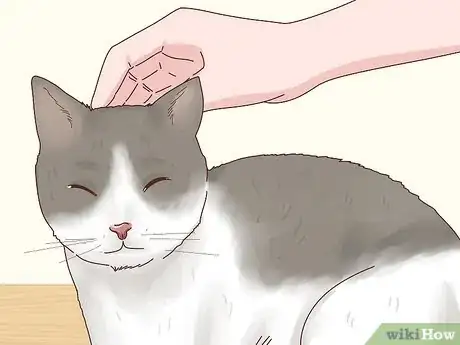This article was co-authored by Pippa Elliott, MRCVS. Dr. Elliott, BVMS, MRCVS is a veterinarian with over 30 years of experience in veterinary surgery and companion animal practice. She graduated from the University of Glasgow in 1987 with a degree in veterinary medicine and surgery. She has worked at the same animal clinic in her hometown for over 20 years.
wikiHow marks an article as reader-approved once it receives enough positive feedback. This article has 13 testimonials from our readers, earning it our reader-approved status.
This article has been viewed 510,714 times.
So, you have a domestic feline at home and you want to make it as happy as possible? Providing for a pet who has its own personality and charm is one of the most satisfying parts of the relationship. You can learn to keep your pet as happy and healthy in life as possible.
Steps
Taking Good Care Of Your Cat
-
1Feed your cat well. The right diet is extremely important for the wellbeing of your cat. Obesity is a common source of problems among domesticated animals. Look for quality cat food in your favourite pet shop and make sure to buy something adapted to its age.
- For quantities, follow the instructions on the food package. However these are just guidelines, Many times the manufacturer overestimate the quantities, so this should always be interpreted in light of whether the cat is losing or gaining weight when fed that amount.
- If you don’t know which brand to choose, talk to your veterinarian. He or she will be happy to help.
- Be careful with treats. Cats are always on the look-out for good food and will beg for their favourite piece of fish. Only give a treat once in a while to avoid obesity.
- Don’t leave meat and fish outside without supervision. Remember that cats can jump high and don’t particularly follow rules. If you aren’t in a room, those delicious sausages on the table might finish their lives in your cat’s belly.
-
2Keep your cat healthy. Felines can catch a variety of illnesses outside and inside the house. It is important to bring your cat to the veterinarian at least two times a year for a check-up. Your cat should be neutered to prevent unwanted babies and lower the risks of feline HIV.
- In a growing number of countries, it is mandatory to neuter your cats to keep the feline population under control.[1]
- Don’t forget to ask for a regular worming and flea treatment, especially if your cat spend a lot of time outside. Cats will be very unhappy if they have to scratch all the time!
- Have your cat chipped by the veterinarian. It can save you a lot of trouble if the animal is lost and found and it is sometimes mandatory.
- Look out for the following symptoms: weight loss, lack of energy, aggressive behavior, eye infection, wounds, limp, dirty ears.
Advertisement -
3Keep its environment clean. Cats have no other choice but to be clean. Being odour-free is indispensable to hunt and survive. As a result, cats are very smell-sensitive and require a spotless environment to be happy.
- Don’t wash your cat. Cats are perfectly able to keep clean and will engage in a lengthy routine to be odour-free. Only wash the animal if it is exceptionally dirty or came in contact with a toxic product which cannot be swallowed.
- Keep the litter box nice and fresh. Cats bury their poo to avoid detection. It is in their nature to expect a clean litter and they might use something else if it is not to their standard. Change it at least twice a week and scoop it once a day.
-
4Pet your cat. Cats usually like to interact with their owners. Try to cuddle your cat at least twice a day and make sure to talk to it. Most cats love to be stroked behind the ears, on both sides of the nose, and under their chin.
- Always stroke the cat from forehead to tail. Place your hand on the head and follow the spine. Don't go against the lie of the fur. Most cats hate it.
- Never touch its tail and paws. Cats hate it!
- A cat might let you stroke its belly if it trusts you. Never try to touch it otherwise as it is a cause of stress for the animal.
- Cats don’t like to be touched for too long. If the animal shows signs of exasperation or stress, immediately stop.
- Cats are sometimes unpredictable. Always stay with a child when stroking a cat. Show your child how to gently touch the feline and avoid any quick movement. The cat will scratch if it feels threatened.
Stimulating The Cat In The House
-
1Give your cat freedom. Cats need their own private space to feel happy. Don’t always try to interact with them and let them do their own things. Let the cat have a quiet space in the house where the children will not harass it.
- A cat’s personal space doesn’t have to be big. Cats love confined spaces, such as cardboard boxes, and will happily use them to take a nap.[2]
- Try to grow a plant of cat grass near your cat’s private space. This special plant helps their digestive system and doesn’t trigger vomiting like garden grass.
- You can buy a basket for your cat at the pet shop. Look for one model that you can clean easily as it can get dirty or smelly over time.
- Let your cat look at a window. They love observing birds and people.
-
2Provide entertainment. Cats are independent animals and will cope well when you’re at work. You can, however, make sure that they have enough toys to keep busy. You can buy cat toys in most pet shops and supermarkets. When you come home, don’t forget to play! Cats need exercise.[3]
- You can also make your own cat toys. Attach a piece of string to a door handle and let the cat go wild.
- Alternatively, you can offer your cat a small ball. Your animal will chase it as if it were prey.
- Provide a scratching post or your furniture will suffer.
- Use a laser or a flashlight and point it at the floor. Your cat will try to catch the light and will get very excited.
-
3Adopt another cat. Cats work well on their own but are also happy to have company. You could consider getting another cat if you work long hours and if you have the space and the energy. Don’t forget to neuter them or you might end up with a feline army![4] To introduce a new cat, use the following steps:
- The resident cat will often display hostility at first. Isolate the new cat at first and let it get used to the room. Your old cat will not see it but will be able to scent it.
- Introduce your cats at mealtime but put the feeding stations at opposing sides of the room. Separate them after the meal and start again for the next days.
- After a few more days, let them meet but always monitor the situation. If there is any violence, separate them quickly and repeat the next day.
Exploring The Outdoors
-
1Organize your garden. You will need to think about a few things before letting your cat out. You should provide a place to sleep outside. Cats love to take a nap in the garden. Find a place in the shade and protect it from the rain. Equip your backdoor with a cat door so your animal can come and go. Place a bit of food in a protected area.
- Be careful about the food you leave outside. Make sure that it’s not eaten by other animals.
- Bring your cat for a check-up before letting it outside. Talk with the veterinarian about the dangers and the things to look for.
-
2Allow your cat to get out. There are many debates as whether a cat can be truly happy kept inside. If you have green space around the house, consider letting it out. Your cat is a predator and will enjoy the outside. It’s a great way to keep your feline fit.
- Be careful if you live next to a busy road. Cats don’t react so well around cars.[5]
- Follow your cat in the first days and don’t let it go too far. Your feline needs time to get used to its new surroundings.
- Look for other cats. They might consider your garden as their territory and will look at your cat as a threat.
- Don’t have too much faith in your fences to keep the cat inside the garden. They will inevitably find a way to escape.
- It can be a good idea to keep a collar on your cat, but some cats may become snagged on fences by their collar, which may result in suffocation. Purchase a breakaway collar, which comes off if pulled. A microchip is another option, and most rescuers and veterinarians now scan for them before they proceed with handling the animal.
-
3Let your cat hunt. Don’t try to detract your cat from hunting birds and mice. Your feline, just like its cousin the lion, is a predator and is wired to kill small animals. Don’t forget to make sure that there is no dangerous animal outside. You don’t want your cat to become the prey!
- Your cat will prefer hunting mice and birds. You can also see it chasing flies and other insects.
- Never punish your cat if it hunted and killed another animal. The cat will not understand why it’s being punished!
- Keep in mind that pet cats hunt for fun, not just when hungry, when choosing whether to let your cat outdoors. For every dead mouse or bird your cat brings you, there are probably many others you don't see.
- Don't let your cat outside if you live in an area native to small endangered species.
Expert Q&A
Did you know you can get expert answers for this article?
Unlock expert answers by supporting wikiHow
-
QuestionWhat should I do if my cat is afraid of me?
 Pippa Elliott, MRCVSDr. Elliott, BVMS, MRCVS is a veterinarian with over 30 years of experience in veterinary surgery and companion animal practice. She graduated from the University of Glasgow in 1987 with a degree in veterinary medicine and surgery. She has worked at the same animal clinic in her hometown for over 20 years.
Pippa Elliott, MRCVSDr. Elliott, BVMS, MRCVS is a veterinarian with over 30 years of experience in veterinary surgery and companion animal practice. She graduated from the University of Glasgow in 1987 with a degree in veterinary medicine and surgery. She has worked at the same animal clinic in her hometown for over 20 years.
Veterinarian Take things slowly and know that it takes time to win a cat's trust. Avoid staring at her as this is a threat in cat-language. Keep some tasty treats in your pocket and drop them on the floor near her, so she associates you with nice things. Try lying on the floor to watch TV, so you are not so tall and threatening. Always speak softly and move slowly when in her presence. It will take time but you will get there.
Take things slowly and know that it takes time to win a cat's trust. Avoid staring at her as this is a threat in cat-language. Keep some tasty treats in your pocket and drop them on the floor near her, so she associates you with nice things. Try lying on the floor to watch TV, so you are not so tall and threatening. Always speak softly and move slowly when in her presence. It will take time but you will get there. -
QuestionI have a house next to some pretty aggressive dogs and I don't want her wandering about on our street as the dogs are out often and she is still kinda small. How should I introduce her to the outdoors?
 Pippa Elliott, MRCVSDr. Elliott, BVMS, MRCVS is a veterinarian with over 30 years of experience in veterinary surgery and companion animal practice. She graduated from the University of Glasgow in 1987 with a degree in veterinary medicine and surgery. She has worked at the same animal clinic in her hometown for over 20 years.
Pippa Elliott, MRCVSDr. Elliott, BVMS, MRCVS is a veterinarian with over 30 years of experience in veterinary surgery and companion animal practice. She graduated from the University of Glasgow in 1987 with a degree in veterinary medicine and surgery. She has worked at the same animal clinic in her hometown for over 20 years.
Veterinarian Take her out on a harness to start with, so that she becomes familiar with the sights, sounds, and smells of the neighborhood. She will quickly realize there are dogs in the area and be cautious about going near them. The first few times she goes out without the harness, go with her. Do this before a meal so you can shake some biscuits to get her attention if she goes too far.
Take her out on a harness to start with, so that she becomes familiar with the sights, sounds, and smells of the neighborhood. She will quickly realize there are dogs in the area and be cautious about going near them. The first few times she goes out without the harness, go with her. Do this before a meal so you can shake some biscuits to get her attention if she goes too far.
References
- ↑ http://www.rspca.org.uk/adviceandwelfare/pets/cats/health/neutering
- ↑ http://www.telegraph.co.uk/news/health/pets-health/11392116/Why-do-cats-love-chilling-out-in-boxes-so-much-Scientists-could-have-the-answer.html
- ↑ http://www.knowyourcat.info/getcat/indoorcats.htm
- ↑ http://www.cats.org.uk/shetland/news/introducing-a-new-cat-to-a-resident-cat
- ↑ http://www.rspca.org.uk/adviceandwelfare/pets/cats/health
About This Article
If you want to make your cat happy, give it plenty of space to roam. Place toys, scratching posts, cat grass, and other items in your cat’s environment to keep it entertained when you’re not around. Cats love to play with toys attached to a string, balls with small bells, and wadded up pieces of paper. Whenever you get the chance, offer your cat your attention and affection. In particular, your cat will probably like it when you pet around the top of its head and the back of its neck. For tips from our veterinary reviewer on providing your cat with basic care, keep reading!








































































